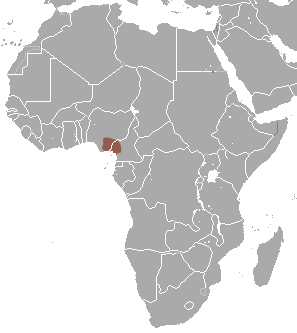Calabar angwantibo facts for kids
Quick facts for kids Calabar angwantibo |
|
|---|---|
 |
|
| Conservation status | |
| Scientific classification | |
| Genus: |
Arctocebus
|
| Species: |
calabarensis
|
 |
|
| Calabar angwantibo range | |
The Calabar angwantibo (also called the Calabar potto) is a small, furry animal. It's a type of primate, like monkeys and humans. This animal belongs to the Lorisidae family, which includes other slow-moving primates. It is closely related to the potto and different kinds of lorises.
Contents
Where Calabar Angwantibos Live
The Calabar angwantibo lives in the warm, wet rainforests of West Africa. You can find them in countries like Cameroon, Nigeria, and Equatorial Guinea. They especially like areas where trees have fallen, creating open spaces. Sometimes, if forests are cleared, they can even live on farms. The animal gets its name from the city of Calabar in Nigeria.
What Calabar Angwantibos Look Like
Calabar angwantibos are small, weighing about 266 to 465 grams. That's less than a pound! They have orangish-yellow fur on their backs. Their bellies are grey or white. A special white line runs down their forehead and nose.
Special Features of Angwantibos
Like other animals in the loris family, the Calabar angwantibo has a very short index finger. This helps them get a super strong grip on tree branches. They also have a special claw on the second toe of each foot. They use this claw for grooming themselves. The Calabar angwantibo is also the only primate with a working nictitating membrane. This is like a third eyelid that helps protect their eyes.
How Calabar Angwantibos Live
Calabar angwantibos are nocturnal, meaning they are active at night. They are also arboreal, which means they live in trees. They usually stay lower in the trees than other night-active primates, often between 5 and 15 meters above the ground. They move very slowly through the trees. They always hold onto branches with at least three of their limbs at a time. During the day, these angwantibos sleep under thick leaves. They hang upside down from a branch while they rest.
What Calabar Angwantibos Eat
The main food for a Calabar angwantibo is insects, especially caterpillars. They also enjoy eating some fruit. They are not picky eaters and will even eat strong-smelling insects that other animals avoid. Before eating a caterpillar, the angwantibo carefully wipes it with its hands. This helps remove any tiny, poisonous hairs.
How Calabar Angwantibos Protect Themselves
When a predator tries to attack, the Calabar angwantibo has a clever defense. It will roll up into a tight ball. But it keeps its mouth open under its armpit. If the attacker keeps bothering it, the angwantibo will bite and hold on tight!
Calabar Angwantibo Family Life
Calabar angwantibos usually look for food alone. However, each male's territory overlaps with the territories of several females. They show they are friends by grooming each other. They also use scent-marking to communicate.
Baby angwantibos are born after about 131 to 136 days. This is how long the baby grows inside the mother. Young are usually born between January and April. When they are born, their eyes are already open. They can also cling to their mother's fur right away.
In Literature
The Calabar angwantibo has appeared in books! It is mentioned in the Aubrey–Maturin novels by Patrick O'Brian. In these stories, a character named Stephen Maturin gets a Calabar angwantibo and becomes very fond of it.
The search for an angwantibo is also a small part of Gerald Durrell's first book, The Overloaded Ark.


